
Published by: Keith Gooberman
Chief Executive Officer
10/20/2021

How do we prepare for the world with no cookies (and less addressability in general)?
Introduction
The focus of Apple to double down on its strategy on ‘privacy for the consumer’ is well publicized. And rightly so. The question on “how much tracking will the average joe accept on the internet” is a difficult one to frame, and a difficult one to answer. It is now accepted in the advertising community that the universe is moving towards a focus on consumer privacy and restricting advertiser’s signals.
In this flourishing ad tech community, much angst has built up in preparation for Google’s Chrome browser to restrict third party cookies. Third party cookies are very important in the addressability of programmatic advertising. which has a substantial market share in the browser wars . The tightening of signals for making advertising decision on a 1:1 basis. I speak about this a lot here as well: https://pontiac.media/post-cookie-era-update-feb-2021/
Programmatic Advertising is very closely discussed with regards to “audience”. Audience, by definition, is the group exposed to content. In this case, an advertisement. The audience must be identified using identifiers to sell or transact ‘audience data’. The world of audience data and “third party data” is enormous and includes all types of data.
Addressability, or the ability to track devices using cookies, mobile identifiers, etc., is always a large focus of “finding your audience”. It is very closely related to advertiser performance metric and the ability of platforms to build optimization into the media. This has shown up very recently as Snap Chat and Facebook all admitted to issues with regard to the Apple iOS 14 release. If this is problematic, they better get ready for a world without cookies.
The ability to target and track audience is difficult today, but will be much harder in the future. Safari browser does not allow cookie tracking. Neither does Firefox. Yet, they still make up much of the ecosystem today. This is actually a good thing. It creates a window into the future where we can learn and play. What can we take away from the current situation that will help us prepare for the future?
What should Brands do now with their Programmatic advertising to prepare?
There are three separate situations which we should address. These are the three variations of identity which will be available going forward and can account for every type of programmatic advertising in one way or another:
- Cookies & Opted-In Folks
- Identity Solutions
- The Un-addressable Universe
Before delving into what will be dramatically different in each of these phases, I first want to discuss a basic version of the sales funnel when looking at Programmatic advertising:
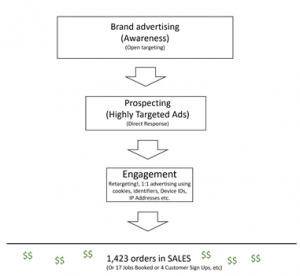
There are many questions to consider when considering this sales funnel. Thinking beyond the type of strategy utilized in each category, we should also consider what exactly happens when the identity of the user is obfuscated. Engagement will no longer work.
Cookies & Opted-in Folks
The first thing to consider is that a certain percentage of internet users will still have third-party cookies turned on and ‘share across all apps’ selected on iOS, and we will still be able to use the methods of today. This is pretty simple: advertisers can operate as they always have. The question of course becomes: how much of the whole universe still will fall into this category?
Identity Solutions
An entire world exists with companies who are building different types of identity solutions. When using a publisher’s first party data to define a user, there is the ability to address specific audiences without the use of third-party pixels. There will definitely be a large number of users who fall into this category. Publishers and the new ‘identity’ companies will have solutions to target a set of users and also measure the effectiveness of the advertisements through these users.
If you are working with some of the identity solutions today, you can begin to test the types of targeting available and get a little bit of insight into other process and scale. It is also recommended to start working with some of the largest endemic or semi-endemic publishers to develop relationships to leverage their audiences and start testing, getting baselines, etc.
The Un-Addressable Universe
This is a huge question, but it is not completely unchartered territory. Today, Safari does not allow third party cookies, giving us a valuable glimpse into the future. The issue when dealing with the loss of identifiers is the removal of the engagement phase and the inability to measure directly back to the effectiveness of the media in most cases (post-click will still work).
Using the funnel from before, things will be similar, but we will not have the ability to engage 1:1 on the bottom level using programmatic advertising.
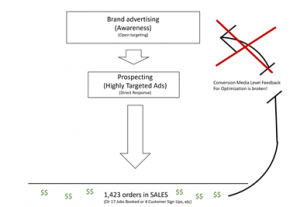
This creates a situation where you must use separate types of targeting: contextual, zip code based, cohort based, etc. There are still ways to identify and target the audience. For example, detailed machine learning on publisher’s websites that use the full domain of where the ad serves and detailed Native advertising campaigns, to name two. There are many types of ways to effectively brand and prospect using Programmatic advertising. In fact, CTV is almost entirely a brand advertising play!
There is a metric which will vanish: post-view conversions. These are conversions that we’re measured when someone saw an advertisement, but did not click on the ad. This is a large part of conversions attributed to all platforms, including programmatic. Post-click conversions are still going to be fine. But ultimately this method of attributing conversions and the optimization circle will be hindered. This however is not a total loss.
There will be many ways of identifying the folks who purchased and how they arrived and traveled through the funnel. While this is not the most elegant graphic, this shows that marketers will know they are spending money, and they will know the overall number of conversions. This can be applied to a state-by-state analysis. A zip code by zip code analysis. And other intelligence ways to identify and track overall effectiveness of the media.
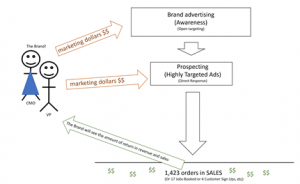
Conclusion
The fact there are three distinct areas marketers can test and begin to strategize is surprisingly simple. What leads us to speculation and confusion is how much of the internet and digital advertising is going to fall into each category.
In 2024, after things have changed and privacy continues to move towards anonymization, it may look something like this:
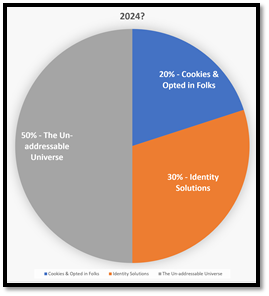
I believe the graph above is the best-case scenario. Depending on how the solutions gain ground and what type of privacy law comes in, there will be different levels of how much is Cookies & Opted in.
There has already been some pushback on identity solutions because they need to join to a hard-persistent-identifier or they are not transferable from publisher to publisher and platform to platform. Often, this is discussed as an email address. This is a ‘perfect world’ solution and would have numerous benefits. “Putting the power in the user’s hand”. But, unless this is opt-out, this type of solution is going to have trouble gaining speed. I could be wrong, but even at scale, it will be difficult to compete with the size of the full open internet.
This graphic paints a much grimmer picture. This is the potential breakdown that would scare many folks in the ad tech business. And, it is possible:
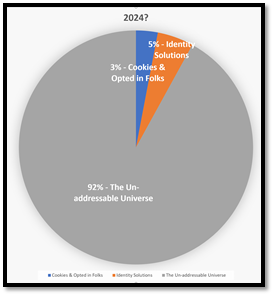
Here at Pontiac Intelligence, much of our focus has been dedicated to learning how to run excellent advertising campaigns in the un-addressable. There is a lot of value on Apple devices and when using zip codes, census information, mobile data companies, multi-touch attribution companies and more, we can put together a nice indication of how things are performing and how to attribute value to the media. Much is integration and understanding conversion rates on certain types of landing pages, etc. And remember, click based tracking still works fine, no matter which environment.
Since the advent of public television advertising budgets have been dominated by linear tv spend and the approach to a media plan has never veered too far from the standard blueprint. Advertisers have always been targeting specific content and demographics that they believed to be their target audience. Most of the time that was a call to Neilson to identify the content along with a DMA that was relevant to their product. Seal, stamp, and deliver…
The promises of digital advertising; advanced targeting and reduced waste, although diluted because of the lack of personal identifiers, still exists in CTV. In the bid request, according to Open RTB 2.5 (the current standard) we get access to app, time of day, postal code, network, channel, title, and series and can decision on this inventory in real time. In addition, this is on an impression-by-impression basis offering potential for efficiencies that are not possible when casting a wide net, as is the case with linear tv.
This all sounds great but when digging deeper we get a different picture. The reality is that the CTV space is still young and unregulated. The data associated with these bid requests is still unstandardized, incomplete, and fragmented. Although app, time of day, postal code, network, channel, title, and series are available fields in the bid request they are usually only partially populated. For example, some requests come in with only network and channel populated while others come in with title and series; some have just one and others have everything. Adding to the confusion, not only is the level of data transparency inconsistent across the industry, but the fields are inconsistently populated within bid requests from the same PMP, publisher, or media owner.
Something of particular concern is the obfuscation of geo location. The postal code is derived from the IP address on the exchange side through mapping provided indirectly by the cable companies. This is one field that is fundamental to local advertising and demographic targeting at the broadest (and privacy safe) level yet many bid requests come in with a truncated IP and no postal code. Some of this opacity can be attributed to laziness but most of it is strategic. Publishers may not want CTV buyers to know exactly what they are buying because what they are offering is not always the highest quality inventory. Buyers none the less must fill budgets at both ends of the inventory spectrum and are willing to spend some of their budget on murkier inventory to keep down CPMs.
Linear is expensive, broad reaching and inefficient but the buyer is explicitly getting what they paid for. Can CTV compete and challenge the Goliath? CTV can certainly complete, but can it truly replace linear TV advertising as a superior alternative, we have the tools but not quite yet. As digital marketers and publishers we must push the industry in the right direction and get CTV to live up to the expectations that digital advertising promise. We need full transparency on inventory if we have any hope in finally starting to see a meaningful shift from linear to digital TV buying. As buyers we can drive this by targeting sellers or apps that offer better transparency and as publishers, we can start to market our inventory as truly transparent. If this can be achieved the advantages of digital marketing for TV budgets is undeniable and we will have a more legitimate, mature industry to show for it. Not to mention more cash flow.
Pontiac offers fully transparent reporting and planning tools. We are happy to share every field that we see in our bid requests to make sure our clients are getting the inventory that they expect.
